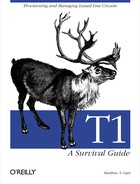Much of this book is about physical networks. Several standards apply to the physical-transmission medium, many of which were originally derived from AT&T technical publications.
Although 56/64-kbps leased lines, also known as DDS leased lines, were not a major component of this book, much of the information presented about T1 can be applied to them. These two standards define the DS0:
AT&T laid the foundations for T1 networking. As a result, two AT&T technical publications lay the foundation for subsequent engineering standards:
- ANSI T1.231
“Digital Hierarchy—Layer 1 In-Service Digital Transmission Performance Monitoring”
T1.231 describes the error conditions that may occur on T1 and T3 circuits and what equipment must do to monitor for error conditions. Appendix C is an introduction to the T1-specific parts of T1.231.
Like many other endeavors, the secret to WAN success is timing. Several specifications set limits on timing performance, which must be achieved by digital networks:
- ITU Recommendation G.821
“Error performance of an international digital connection operating at a bit rate below the primary rate and forming part of an integrated services digital network”
This recommendation defines the acceptable error rates for international leased-line connections operating at less than primary rate (T1 or E1) speeds. Performance targets are, however, independent of the physical network medium used.
- DISA circular 300-175-9 (8 June 1998)
“DII Operating-Maintenance Electrical Performance Standards”
DISA, the Defense Information Systems Agency, maintains the Defense Information Infrastructure (DII), a data network used by the U.S. Department of Defense. This circular, which is available from http://www.disa.mil/pubs/, discusses the performance requirements for leased lines used in the DII.
Once the telco line is terminated by the CSU/DSU, a serial link is used to connect the CSU/DSU to the customer router. Several specifications define the characteristics of that serial link:
- ITU Recommendation V.24
“List of definitions for interchange circuits between data terminal equipment (DTE) and data circuit-terminating equipment (DCE)”
This recommendation defines the generic circuits used on a serial interface of any type. It forms the basis for a great deal of the ITU’s work on serial communications.
- ITU Recommendation V.35
“Data transmission at 48 kilobits per second using 60-108 kHz group band circuits”
V.35 is a label attached to most devices that terminate leased lines and have serial interfaces for attachments to routers. V.35 is obsolete; a good number of devices labeled “V.35” are actually V.36, V.37, or V.38.
- ISO/IEC 2593
“Information technology—Telecommunications and information exchange between systems—34-pole DTE/DCE interface connector mateability dimensions and contact number assignments”
This standard defines a standard 34-pin metal connector designed for use in serial-communication applications. It was adopted by V.35 and its successors and is commonly used for serial interfaces that connect to telecommunications devices. Unlike many ISO standards, this standard is available in English only.
Signaling was an important part of the early T1 specifications. Two major standards were used:
- EIA/TIA 464
“Requirements for Private Branch Exchange (PBX) Switching Equipment”
Private Branch Exchanges (PBXs) are used to connect customer telephones to the telco’s trunk lines. Frequently, PBXs incorporate T1 interfaces in order to serve high-capacity telephone sites. T1 interfaces must incorporate the inter-switch T1 signaling so that the PBX and the CO switch can communicate.
A great number of ISDN standards have been written. ISDN is often pejoratively referred to as “Interesting Services Doing Nothing” or “IS it Done Now?” because the ongoing standardization process can be time consuming. Here is a list of standards:
- ITU Recommendation Q.931
“Recommendation Q.931 (05/98)—ISDN user-network interface layer 3 specification for basic call control”
Call-control signaling on the D channel is specified in Q.931. It is baroque, complex, and confusing. You should dare to tread in these waters only for a specific purpose. Before embarking on a journey through these woods, make sure to tell a good friend or two so they can call for help if you fail to show up at your intended destination on time.
